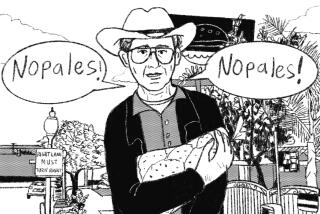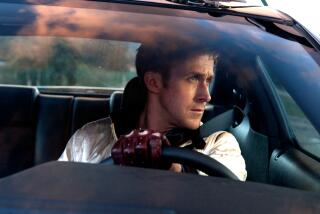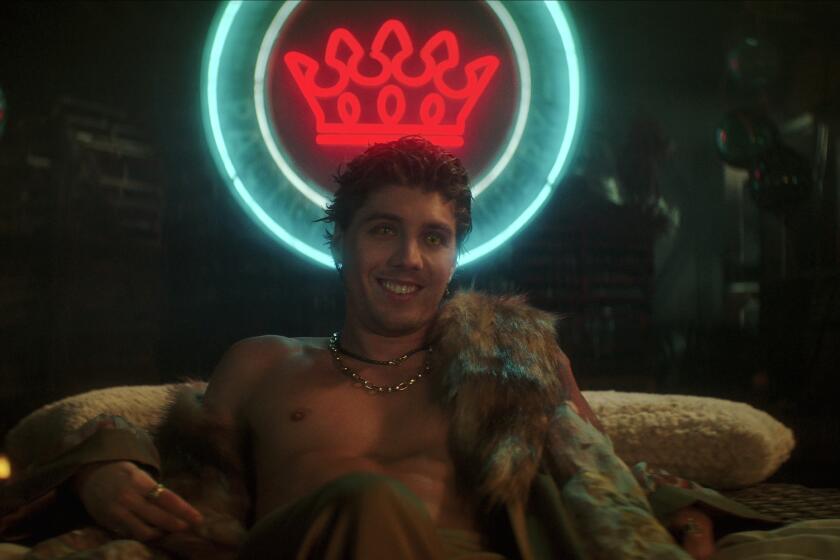Chris Weitz’s ‘Better Life’ shines light on illegal immigrant issues
Premier Fiesta Mexicana is the kind of working-class bar that most Southern Californians drive past without even seeing. The Bell Gardens restaurant and nightclub offers a dinner show with mariachi music and is packed most weekends, but on a summer night nearly a year ago, Carlos Galindo wasn’t there looking for a good time. He was looking for a truck — and a way out of a desperate situation.
Carlos, the lead character in director Chris Weitz’s “A Better Life” — a new movie about the personal struggles of a Mexican gardener in the United States illegally — had scraped together every last dollar to buy a used pickup. With the vehicle, Carlos (played by Mexican star Demian Bichir) could become his own boss, build a landscaping business and care better for his teenage son, Luis (newcomer Jose Julian), who was drifting toward gang life. But mere hours after Carlos closed the truck sale, a day laborer stole his pickup, and Carlos was trying to find it in Premier Fiesta Mexicana’s parking lot.
The truck theft is the kind of infuriating but minor crime most people would handle with a call to the police and an insurance agent. But one of the central themes of “A Better Life,” which premieres Tuesday at the Los Angeles Film Festival and opens in limited release on Friday, is that those kind of easy options aren’t available to illegal immigrants. People like Galindo may collectively sustain the mansions of Los Angeles, “A Better Life” argues, but individually they are as vulnerable as a house of cards.
“All he does is work,” Weitz said of Carlos during a break in filming at the bar. “He is invisible — and he prefers to remain invisible. Because to raise his head is to risk getting in trouble.”
To remain in the shadows necessitates concentric circles of concealment. “It might as well be a science-fiction film,” Weitz added of how he and screenwriter Eric Eason tried to reveal the hidden layers of an illegal immigrant’s life. “There are worlds within worlds within worlds — almost a parallel universe.”
“A Better Life” seems like the kind of mid-budget ($10-million) production — with swaths of dialogue in Spanish and no actors recognizable to mainstream ticket buyers — that would premiere at the Sundance Film Festival looking for a distribution deal. But instead, the film was co-financed and will be released by Summit Entertainment, and made by the man behind one of the studio’s biggest hits: Weitz directed Summit’s “Twilight Saga: New Moon.”
“A Better Life’s” path to the screen, however, was anything but fast, stretching over decades.
Back in 1989, television producer Paul Junger Witt, best known for the series “Soap,” “The Golden Girls” and “Empty Nest,” heard a story about a gardener who had his truck stolen. “I immediately thought of ‘The Bicycle Thief,’” Witt said, a reference to the landmark 1948 Italian film about a father and his son searching for a bike without the police’s help in Rome. “It’s a simple story, but it puts a human face on an invisible slice of the population.”
At various stages, the film (previously called “The Gardener”) was in development at Sony Pictures and going to star Cheech Marin or Andy Garcia and be directed by Luis Valdez (“La Bamba,” “Zoot Suit”) or screenwriter Roger Simon (“Enemies: A Love Story”). But it never gathered enough momentum. “People didn’t know how to promote it,” Witt said of the film’s long gestation. “They didn’t know how to sell it.”
Simon’s screenplay was eventually revised by Eason (“Manito”), which then landed among a stack of scripts sent to Weitz. At the time, Weitz was talking to Summit about making another “Twilight” movie — “Breaking Dawn,” which was ultimately directed by Bill Condon — but felt a personal connection to “A Better Life.” That was in large part because the filmmaker’s grandmother is 100-year-old Lupita Tovar, a Mexican-born actress who emigrated to the United States, and his wife, Mercedes Martinez, is Cuban Mexican.
“Part of the motivation for doing this was to get in touch with my roots,” said Weitz, who took “as many Spanish classes as I could” to communicate with his cast and crew (for about half of them, English was not their first language). Looking up from his monitor as Bichir and Julian walked through the nightclub’s parking lot in search of the truck, Weitz said “más despacio,” Spanish for slower. “Buen hecho,” Weitz said after the scene was finished — well done.
In his drive to infuse the production with as much authenticity as possible, Weitz and producers Witt, Christian McLaughlin, Jami Gertz and Stacey Lubliner (Gertz and Lubliner’s Lime Orchard Productions co-financed the film) traveled to all corners of Los Angeles, about 70 locations including the Romana Gardens housing development in Boyle Heights.
The filmmakers also worked with Father Gregory Boyle’s Homeboy Industries and the community organizing Legacy LA not only to make sure the script mirrored neighborhood vernacular — kids call their fathers “apa” and not “papi,” for instance — but also to help round out the film’s cast with former gang members. One such person, Richard Cabral, who has a small part in “A Better Life,” was discovered at a Homeboy casting session.
“It felt inherently wrong to tell this story without the right people to tell it,” said Weitz, who collaborated with Spanish cinematographer Javier Aguirresarobe and costume designer Elaine Montalvo, the daughter of a migrant farm worker. A local taco truck catered on some days, on others food was provided by a Mexican American-run company. “A lot of the approach has been to been to integrate as much reality as possible,” Weitz said.
As father to a now 4-year-old boy, Weitz said he connected with the screenplay’s father-son tale. “The father is a good and decent man, but doesn’t have enough time to parent his son. And the son has the usual teenage issues with authority and his father,” the director said. “But the son is deracinated — he’s stuck between a Mexico he doesn’t know much about and an American popular culture he doesn’t quite understand. He’s never fully at home.”
In looking for the pickup, the father and son grow closer — even as the task exposes Carlos to possible deportation. “The issues that the film raise are the biggest ones,” Weitz said. “It’s about the love of a father for a son.”
While Weitz and McLaughlin call the film “apolitical,” the movie nevertheless has a point of view about immigration: Our current laws destroy families, deportation is only a temporary (and pitiless) remedy, and put in the same situation many of us might do exactly what Carlos (and the illegal immigrants that he represents) does — survive by any means necessary.
“When you turn a camera on somebody, you inherently humanize them,” Weitz said of how the film depicts Carlos. “I hope that once you see the movie, it will be hard to look at Mexican American immigrants as the others.” Said screenwriter Simon, once a liberal who is now a conservative blogger: “This is an issue where the left and the right should start talking with each other in a straightforward way.”
Summit is trying to sell “A Better Life” to two distinct audiences — the largely Caucasian art-house crowd, and working-class Latinos. It’s a tricky strategy, and even when it works, as with 2008’s “La Misma Luna,” the returns are good but not great (that film grossed $12.6 million). When the dual-track campaign doesn’t work, the proceeds can be paltry: 2006’s “Quinceanera,” winner of Sundance’s top drama prize, grossed just $1.7 million.
Bichir believes the film holds wide appeal. “This movie isn’t about having papers or not. It’s about fulfilling your dreams and taking care of your blood,” the actor said. “I think immigration is going to be the main issue around the world for the next 20-30 years. There isn’t a single activity where an immigrant isn’t involved. And especially Mexican illegal immigrants.”
Times staff writer Nicole Sperling contributed to this report.
More to Read
The biggest entertainment stories
Get our big stories about Hollywood, film, television, music, arts, culture and more right in your inbox as soon as they publish.
You may occasionally receive promotional content from the Los Angeles Times.






